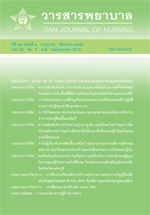ความสัมพันธ์ระหว่างความรู้แรงจูงใจ และทักษะในการคุมกำเนิดกับพฤติกรรม การคุมกเนิดของนักเรียนอาชีวศึกษาหญิงวัยรุ่นในเขตภาคใต้ตอนบน
Main Article Content
Abstract
1. พฤติกรรมการคุมกำเนิดของนักเรียนอาชีวศึกษาหญิง มีความสัมพันธ์ทางบวกกับความรู้ในการคุมกำเนิด (r = 0.38) ทัศนคติต่อการคุมกำเนิด (r = 0.45) การรับรู้ผลเสียของการตั้งครรภ์ (r = 0.39) การรับรู้สมรรถนะของตนเองในการคุมกำเนิด (r = 0.43) และการสนับสนุนของคู่นอนในการคุมกำเนิด (r = 0.29) อย่างมีนัยสำคัญทางสถิติที่ระดับ .05
2. การรับรู้สมรรถนะของตนเองในการคุมกำเนิด การรับรู้ผลเสียของการตั้งครรภ์ ทัศนคติต่อการคุมกำเนิด และความรู้ในการคุมกำเนิด สามารถร่วมทำนายพฤติกรรมการคุมกำเนิดของนักเรียน อาชีวศึกษาหญิงได้โดยอธิบายความแปรปรวนได้ร้อยละ 34.4 อย่างมีนัยสำคัญทางสถิติที่ระดับ.05 ส่วนการสนับสนุนของคู่นอนในการคุมกำเนิดไม่สามารถร่วมทำนายได้
Relationships between information, motivation, contraceptive behavioral skill and contraceptive use of Vocational female students in the upper south of Thailand.
Narkarat, P., & Thato, R.
The purposes of this correlational predictive design were to examine the correlation between information about contraception, attitude toward contraception, perceived negative consequences of pregnancy, partner support regarding contraception, self efficacy toward contraception and contraceptive use and to identify predictive factors of contraceptive use. Two hundred and fifty nine vocational female students in the upper south of Thailand were selected using the multistage random sampling. Data were collected using a test of an information about contraception and the questionnaires regarding to attitude toward contraception, perception of negative consequences of pregnancy, self efficacy toward contraception, partner support regarding contraception and contraceptive use. The questionnaires were tested for their content validity by a group of experts. Their Cronbach’s alpha coefficients were 0.67, 0.87, 0.86, 0.88, and 0.88, respectively. Data was analyzed using bivariate correlation and stepwise multiple regression analysis. The results revealed as follows.
1. There were significantly positive relationships between contraceptive use among vocational female students and information about contraception (r = 0.38), attitude toward contraception (r = 0.45), perception of negative consequences of pregnancy (r = 0.39), self-efficacy toward contraception (r = 0.43) and partner support regarding contraception (r=0.29) at p < .05.
2. Self efficacy toward contraception, perception of negative consequences of pregnancy, attitude toward contraception and information about contraception could predict the contraceptive use. These predictors accounted for 34.4 % of total variance at p < .05. Partner support regarding contraception could not predict the contraceptive use.


